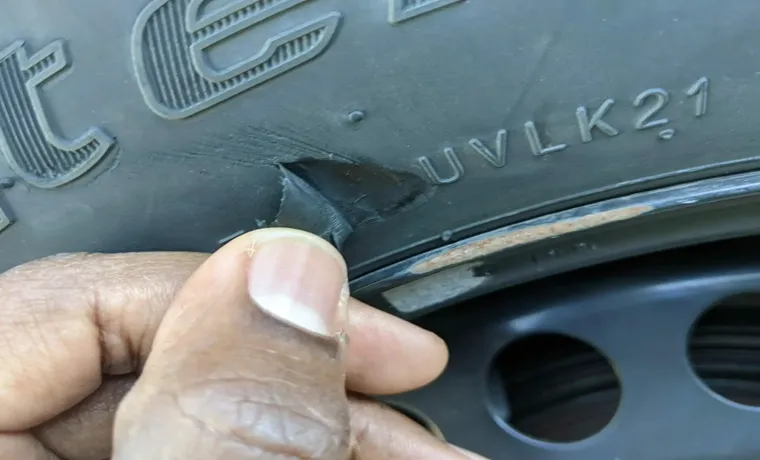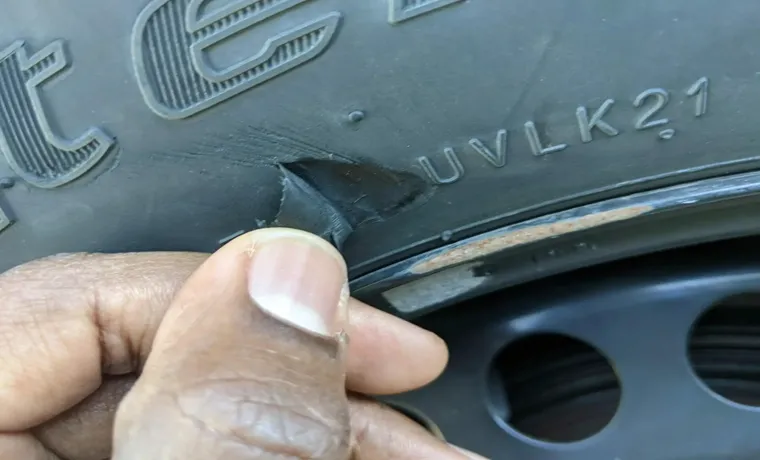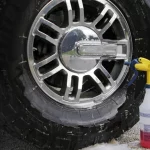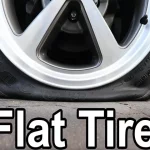Have you ever gone to your car, only to find a flat tire? Frustrating, isn’t it? Much worse is discovering that a tire has a hole in its sidewall. You may wonder how this could have happened. It turns out that there are various reasons why a tire sidewall can develop a hole.
Knowing these reasons can help you avoid future problems. Firstly, hitting a pothole or running over sharp debris can puncture your tire’s sidewall. The impact can create an instant hole, and the damage may be severe enough to cause irreparable harm to the tire.
It’s better to avoid such obstacles whenever possible and drive carefully on the road. Secondly, age can also be a culprit. Old tires become brittle and can crack, resulting in weak spots in the sidewall.
These weak spots are at an increased risk of developing a hole, so it’s essential to replace old tires regularly, especially if you notice signs of aging. Lastly, incorrect tire maintenance can also cause tire damage. Overinflated or underinflated tires can cause bulging and create weak points in the sidewall.
Always check your tire pressure regularly and ensure that you maintain the recommended pressure level. In conclusion, understanding what causes a sidewall hole in a tire can help drivers avoid untimely flat tires and subsequent inconveniences. Driving mindfully, maintaining recommended tire pressure, and replacing old tires before they become a threat can help keep drivers safe on the road.
Table of Contents
Introduction: Understanding the Problem
Have you ever had a flat tire caused by a hole in the sidewall and wondered what could have caused it? It can be frustrating and expensive to replace a tire that has not yet reached its full lifespan. Several factors can cause holes in the tire sidewall, including hitting a sharp object like a nail or pothole at high speed. The sidewall is the weakest point of the tire and is more susceptible to punctures compared to the tread.
A severely worn tire or one that has been exposed to the sun for extended periods can also develop cracks in the sidewall that can lead to a puncture. Additionally, poor maintenance practices such as driving on underinflated tires or exceeding the OEM’s tire pressure recommendation can cause the tire to wear out faster, increasing the risk of sidewall punctures. Therefore, it is crucial to inspect your tires regularly, maintain proper tire pressure, and avoid dangerous driving habits to avoid preventable sidewall damage.
What is a Tire Sidewall
As a driver, you are likely familiar with the term “tire sidewall”, but may not know exactly what it means. The tire sidewall is the area of the tire that bridges the gap between the tread and the bead, connecting the tire to the rim. It is where you will find important information such as the tire size, the manufacturer, and the maximum air pressure.
The sidewall also plays a critical role in the overall performance of the tire, providing stability and allowing it to bear the weight of the vehicle. In a way, the sidewall acts as the backbone of the tire, holding everything together and ensuring that the tire can carry out its intended function. Whether you are a car enthusiast or simply someone who drives to get from point A to point B, knowing the basics of tire sidewalls can help you make informed decisions when it comes to your vehicle’s maintenance and safety.

What Constitutes a Hole in a Tire Sidewall
When it comes to tire damage, one of the most common issues people face is a hole in the sidewall. This can be a frustrating problem as it often means you need to replace the tire altogether. But what actually constitutes a hole in the tire sidewall? Essentially, it is any puncture or damage that occurs on the side of the tire.
This can be caused by a variety of factors such as hitting a curb or driving over debris on the road. One key thing to note is that small scratches or scuffs on the sidewall are generally not considered holes, but larger, more significant damage can be. It’s important to keep an eye on the condition of your tires and address any sidewall damage as soon as possible to ensure your safety on the road.
Common Causes of a Sidewall Tire Hole
A sidewall hole in a tire can be frustrating and unexpected. There are several factors that can cause a hole in the tire sidewall, with the most common being road hazards such as sharp objects. Other factors include driving on irregular or bumpy roads, overloading your vehicle, and contact with the curb or obstacles.
Tire failure due to age and weather conditions can also leave a tire vulnerable to developing sidewall holes. Additionally, improper installation, under-inflation, and over-inflation can cause the tire to wear out quickly and ultimately result in a sidewall hole. To prevent a tire from developing sidewall holes, it is essential always to check your tire pressure and scrutinize the tread for any damage.
It might also be helpful to avoid rough or hazardous roads as much as possible and carry out periodic checks on your tires’ age and condition.
Impact Damage
If you’ve ever experienced a sidewall tire hole, you know how frustrating it can be. One of the most common causes of sidewall tire damage is impact. Rocks, curbs, and other debris on the road can puncture or cut into the tire, causing a hole.
Another common cause of impact damage is hitting a pothole or speed bump too hard. This can cause the tire to bulge or split, leading to a hole. It’s important to regularly inspect your tires for signs of damage or wear and tear, and to drive cautiously to avoid any potential hazards.
If you do encounter a sidewall tire hole, it’s important to replace the tire as soon as possible to prevent further damage or accidents on the road. Trustworthy Sidewall Tire Holes Repair can help you fix any problem that comes with your tire, ensuring your safety and protection on the road.
Road Hazards and Debris
When driving, we often encounter road hazards and debris, which can result in a damaged sidewall of our tire. One common cause of such damage is hitting or running over a sharp object, like a nail, glass, or rock. Such objects can puncture through the tire’s rubber material and strike the sidewall, creating a hole.
Another cause is driving on rough or poorly maintained roads, where potholes, bumps, and cracks can cause the tire’s sidewall to bulge or rupture. Additionally, sidewall tire damage can be caused by overloading the vehicle with excess weight beyond its recommended capacity, which puts extra stress on the tire’s rubber and weakens it over time. To prevent sidewall tire holes, it’s important to be aware of your surroundings when driving and avoid driving over sharp objects or rough roads whenever possible.
Also, make sure to check your tire pressure regularly and avoid overloading your vehicle. By following these simple steps, you can reduce your risk of experiencing a sidewall tire hole and ensure a safe and smooth driving experience.
Poor Maintenance
Poor maintenance of your tires can result in various issues, including a sidewall tire hole. It’s important to be aware of the common causes of this problem so you can avoid them. One cause is driving over debris on the road, like sharp rocks or glass, that can puncture the sidewall of your tire.
Another culprit is hitting curbs or other obstacles while driving, which can cause damage to the sidewall. Over-inflating or under-inflating your tire can also lead to a hole in the sidewall as it causes uneven wear and puts additional stress on the tire. It’s essential to inspect your tires regularly, checking for any signs of damage, and keeping them properly inflated to prevent a sidewall tire hole.
Otherwise, you may find yourself stuck on the side of the road with a flat tire, posing a significant danger to you and other drivers on the road.
Preventing a Sidewall Tire Hole
If you want to avoid a hole in your tire sidewall, there are a few things you can do to prevent this from happening. One of the main causes of a hole in the sidewall is driving over sharp objects, like rocks or nails, which can puncture the tire and cause a hole to form. To avoid this, try to steer clear of roads or areas where there is a lot of debris.
Keep an eye out for potholes or other pavement damage as well, as these can also cause a hole in your tire. Another common cause is hitting curbs or other obstacles while driving, which can cause damage to the tire sidewall. Be sure to avoid hitting curbs whenever possible, and if you do, be sure to inspect your tire afterward for any signs of damage.
By taking these steps, you can help prevent a sidewall tire hole and keep your vehicle running smoothly.
Check and Maintain Proper Tire Pressure
Maintaining proper tire pressure is crucial to preventing a sidewall tire hole. When tires are underinflated, the sidewall is at risk of flexing too much, causing the rubber to weaken and potentially break apart. Additionally, an underinflated tire can cause increased friction and heat buildup, which adds stress to the sidewalls.
On the other hand, overinflated tires can put too much stress on the center of the tire, leading to uneven wear and, eventually, a weakened sidewall. By regularly checking and maintaining the correct tire pressure, you can avoid these issues and keep your tires working for longer. Plus, it’s a simple and easy habit to get into – just take a few minutes every few weeks to check and inflate your tires as needed.
So, don’t neglect tire pressure – your sidewalls will thank you!
Avoid Road Hazards and Debris
When it comes to driving, it’s important to be aware of potential road hazards that could cause damage to your vehicle, including your tires. One common issue that drivers may encounter is a sidewall tire hole, which can be caused by hitting debris or objects on the road. To prevent this type of damage, it’s important to stay alert and keep a safe distance from vehicles in front of you, especially on highways and roads with heavy traffic.
Avoid driving over potholes, curb rash, or any other debris on the road that could potentially puncture your tires. In addition, it’s important to inspect your tires regularly to check for any signs of damage or wear and tear. Taking these precautions can help you avoid costly and unexpected repairs or replacements.
Remember, staying vigilant and being proactive can go a long way in keeping your vehicle in good condition and ensuring your safety on the road.
Inspect and Replace Old Tires
Preventing a Sidewall Tire Hole by Inspecting and Replacing Old Tires Your tires are the only thing between you and the road—make sure they’re in good shape! Sidewall tire holes can be caused by a variety of factors, but one of the most common is old, worn-out tires. Before hitting the road, take some time to inspect your tires for signs of wear and tear. Check the tread depth to make sure it’s not too low, and look for any cracks, bulges, or other damage to the sidewalls.
If you do notice any issues, it’s best to replace the tire as soon as possible. Remember, the cost of a new tire is much less than the potential cost of an accident caused by a blowout or failure. And while you’re at it, make sure all four tires are in good shape—not just the one with the hole! By staying on top of tire maintenance, you can help prevent a sidewall tire hole and stay safe on the road.
Conclusion: Keeping Your Tires Safe and Healthy
In the end, the cause of a hole in your tire sidewall may vary from a sharp object on the road to a manufacturing defect. While we can’t control the elements out on the road, we can ensure that our tires are properly inflated and maintained to reduce the risk of damage. Remember, a little prevention goes a long way in avoiding those annoying sidewall holes, so keep an eye on your tires and roll on with confidence!”
FAQs
What are some common causes of a hole in a tire sidewall?
There are several causes of a hole in a tire sidewall including hitting a curb or pothole, damage from sharp objects on the road, or a manufacturing defect.
Can a tire sidewall be repaired if it has a hole?
No, a tire sidewall cannot be repaired. It is a safety hazard and the tire needs to be replaced.
How can I prevent getting a hole in my tire sidewall?
You can prevent getting a hole in your tire sidewall by avoiding sharp objects on the road, maintaining proper tire pressure, and avoiding hitting curbs or potholes.
What should I do if I notice a hole in my tire sidewall?
If you notice a hole in your tire sidewall, you should replace the tire immediately to prevent a blowout and ensure your safety on the road.
Can a tire sidewall puncture be fixed with a patch or sealant?
No, a tire sidewall puncture cannot be fixed with a patch or sealant. It is a safety hazard and the tire needs to be replaced.
How often should I check my tire sidewalls for damage?
You should check your tire sidewalls for damage every time you check your tire pressure, as part of regular tire maintenance.
Are there any warning signs that my tire sidewall may have a hole or puncture?
Yes, warning signs include bulging or cracking in the sidewall, uneven wear, and vibrations while driving. If you experience any of these symptoms, have your tires inspected immediately.



